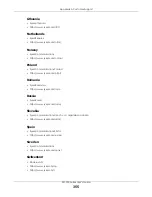
Chapter 48 Port Status
XS1930 Series User’s Guide
345
48.1.2 DDMI
The optical SFP transceiver’s support for the Digital Diagnostics Monitoring Interface (DDMI) function lets
you monitor the transceiver’s parameters to perform component monitoring, fault isolation and failure
prediction tasks. This allows proactive, preventative network maintenance to help ensure service
continuity.
Use this screen to view the DDMI status of the Switch’s SFP transceivers. Click
Management > Port Status >
DDMI
to see the following screen. Alternatively, click
Status
from any Web Configurator screen and then
the
Port Status
link in the
Quick Links
section of the
Status
screen to display the
Port Status
screen and
then click the
DDMI
link tab.
Figure 254
Management > Port Status > DDMI
The following table describes the labels in this screen.
48.1.3 DDMI Details
Use this screen to view the real-time SFP (Small Form Factor Pluggable) transceiver information and
operating parameters on the SFP port. The parameters include, for example, transmitting and receiving
power, and module temperature.
Click a number in the
Port
column in the
DDMI
screen to view current transceivers’ status.
512-1023
This field shows the number of packets (including bad packets) received that were between 512
and 1023 octets in length.
1024-1518
This field shows the number of packets (including bad packets) received that were between 1024
and 1518 octets in length.
Giant
This field shows the number of packets (including bad packets) received that were between 1519
octets and the maximum frame size.
The maximum frame size varies depending on your switch model.
Table 181 Port Status: Port Details (continued)
LABEL
DESCRIPTION
Table 182 Management > Port Status > DDMI
LABEL
DESCRIPTION
Port
This identifies the SFP port.
Vendor
This displays the vendor name of the optical transceiver.
Part Number
This displays the part number of the optical transceiver.
Serial Number
This displays the serial number of the optical transceiver.
Revision
This displays the revision number of the optical transceiver.
Date Code
This displays the date when the optical transceiver was manufactured.
Transceiver
This displays whether the connection to the optical network is up or down.
















































